Netherlands Pharmaceutical Market Size
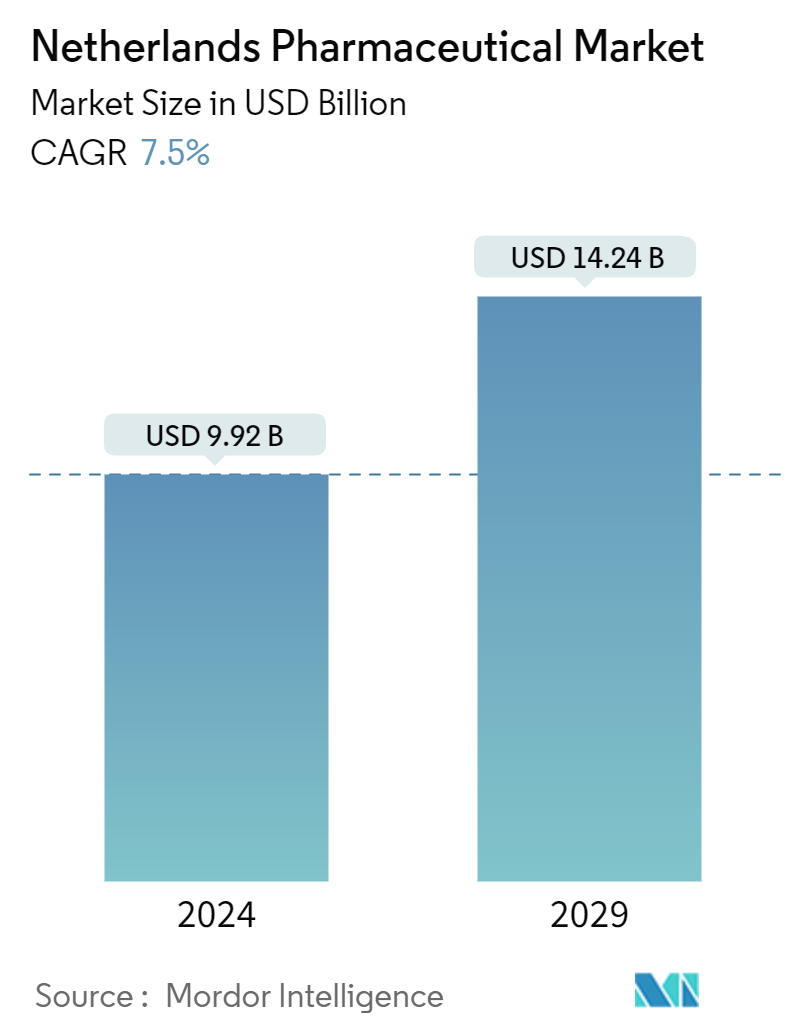
| Study Period | 2019 - 2029 |
| Base Year For Estimation | 2023 |
| Market Size (2024) | USD 9.92 Billion |
| Market Size (2029) | USD 14.24 Billion |
| CAGR (2024 - 2029) | 7.50 % |
| Market Concentration | Low |
Major Players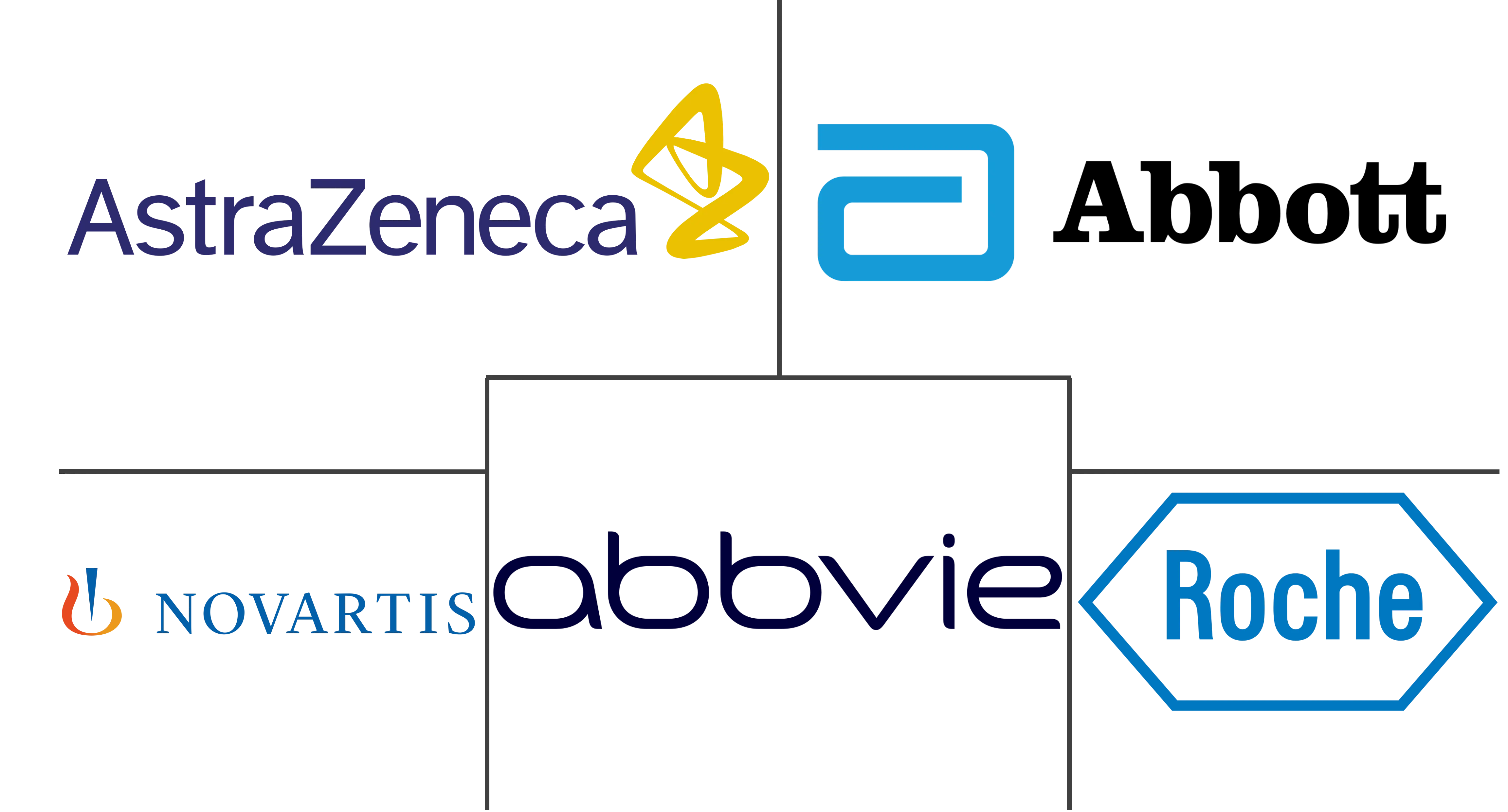
*Disclaimer: Major Players sorted in no particular order |
Netherlands Pharmaceutical Market Analysis
The Netherlands Pharmaceutical Market size is estimated at USD 9.92 billion in 2024, and is expected to reach USD 14.24 billion by 2029, growing at a CAGR of 7.5% during the forecast period (2024-2029).
The COVID-19 pandemic had a significant impact on the market in its early phase due to various lockdown regulations that were imposed. For instance, according to an article published by PubMed Central in January 2021, a cross-sectional study was performed, which showed that there was a considerable impact of the COVID-19 pandemic on both logistic procedures and services in the pharmacies of the Netherlands. The reduction in such services meant fewer pharmaceutical sales. Hence, the COVID-19 pandemic had a significant impact on the market initially. However, post pandemic the market studied is expected to have stable growth during the forecast period of the study.
The presence of world-class research institutes, a highly educated workforce, an excellent healthcare system, and an innovation-friendly government, combined with a central location, makes the country an ideal base for biopharmaceutical operations. Healthcare and medical spending have increased over the past few years, reflecting strong potential for new medicine development, infrastructure building, and new entry/expansion opportunities. At the same time, the government is taking various initiatives to lower the prices of pharmaceutical products, which is expected to have adverse effects on the profitability of pharmaceutical companies. The Netherlands is expected soon negotiate lowering drug prices with pharmaceutical companies.
As per the data published by the Dutch Cancer Society (KWF), in 2021, cancer was the leading cause of death in the Netherlands. According to the same data, in 2021, an estimated 44,996 persons died of cancer, out of which 24,266 were men, and 20,730 were women. Furthermore, according to the data published by the World Bank, in 2022, the prevalence of diabetes as a percentage of the population aged between 20 and 79 was 4.5% in the Netherlands in 2021. Hence with the increasing burden of various diseases, it is expected that there will be steady growth in the market.
Therefore, owing to the aforementioned factors, the market is anticipated to witness growth over the forecast period. However, the high failure rate and developing cost of new products are likely to impede the growth of the market.
Netherlands Pharmaceutical Market Trends
Cardiovascular Segment is Expected to Hold a Significant Market Share over the Forecast Period
Increased cardiovascular diseases are one of the key factors for the growth of the market. According to an article published by the Health Policy Partnership in 2021, in the Netherlands, heart attack and stroke are significant health concerns among the population. It is estimated that over 740,000 people are living with coronary heart disease (CHD), which includes heart attack, and more than 216,000 people had a stroke in 2021, and these numbers are rising. The article also stated that the direct cost of CHD and cerebrovascular disease to the Dutch healthcare system amounts to EUR 2.1 billion (USD 2.38 billion) per year.
Furthermore, according to the European Survey of Cardiovascular Disease conducted by Daiichi Sankyo in July 2022, a survey was conducted in European nations which showed that 82.8% respondents of Netherlands are aware of chest tightening, and 66.7% of the respondents are aware of heart palpitations. The survey also showed that 51% of the respondents made an appointment with healthcare professionals to seek advice about cardiovascular disease symptoms.
Moreover, increasing product approvals and key developments by market players are also enhancing segment growth. For instance, in July 2021, European Medicines Agency (EMA) approved Verquvo throughout the European Union. Verquvo is a medicine used to treat adults with long-term heart failure with reduced ejection fraction who recently received intravenous (into the vein) treatment because of the worsening of their symptoms. Furthermore, in September 2021, Oxitope Pharma BV started its business in the Netherlands as a biopharmaceutical start-up dedicated to discovering and developing antibody-based medicines for treating diseases caused by oxidative stress.
Thus, owing to the increasing disease burden, product approvals, coupled with increasing awareness among people about cardiovascular diseases and better health guidelines, the segment is expected to experience growth in the future.
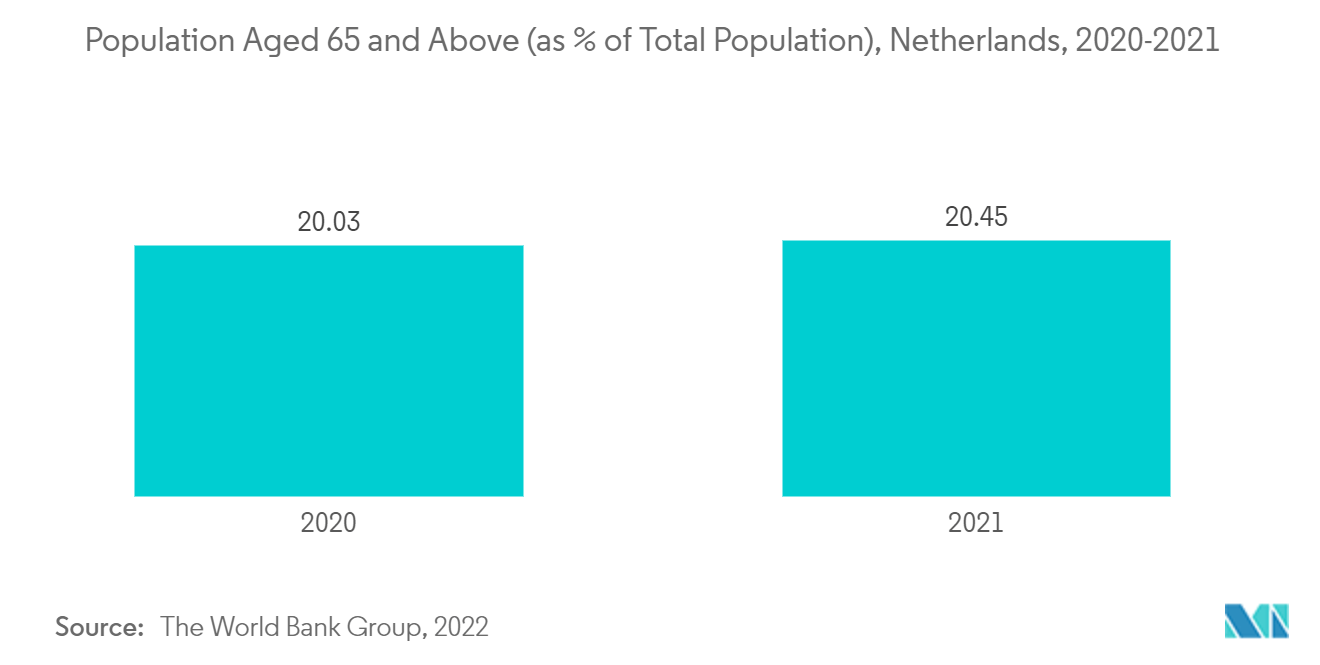
Prescription Segment is Expected to Witness Significant Growth Over the Forecast Period
The major factors driving the growth of the segment are the increasing prevalence of chronic and infectious diseases, the rising research and development activities by major players for new prescription-based drugs, and new product launches by key market players.
The increasing prevalence of infectious diseases in the country is a major factor driving the growth of the segment, as it means more use of prescription-based drugs. For instance, according to an article published by Eurosurveillance in June 2022, in the Netherlands, monkeypox was classified as a group A notifiable disease, which means that suspected and confirmed cases of monkeypox should be immediately notified to the public health services. As of May 2022, 31 monkeypox cases were laboratory-confirmed by PCR in the country.
Moreover, new prescription-based product launches in the country are also enhancing the segment's growth. For instance, in November 2022, Sanofi announced that its prescription drug Enjaymo (sutimlimab) for the treatment of hemolytic anemia in adult patients with cold agglutinin disease (CAD) had received marketing authorization from European Commission (EC). Furthermore, in September 2022, EMA issued a marketing authorization for Tezspire that is valid throughout the European Union. Tezspire is a prescription-based drug for the treatment of severe asthma.
Hence, due to factors such as the increasing prevalence of infectious diseases and rising product launches by key market players, the prescription segment is expected to experience growth.
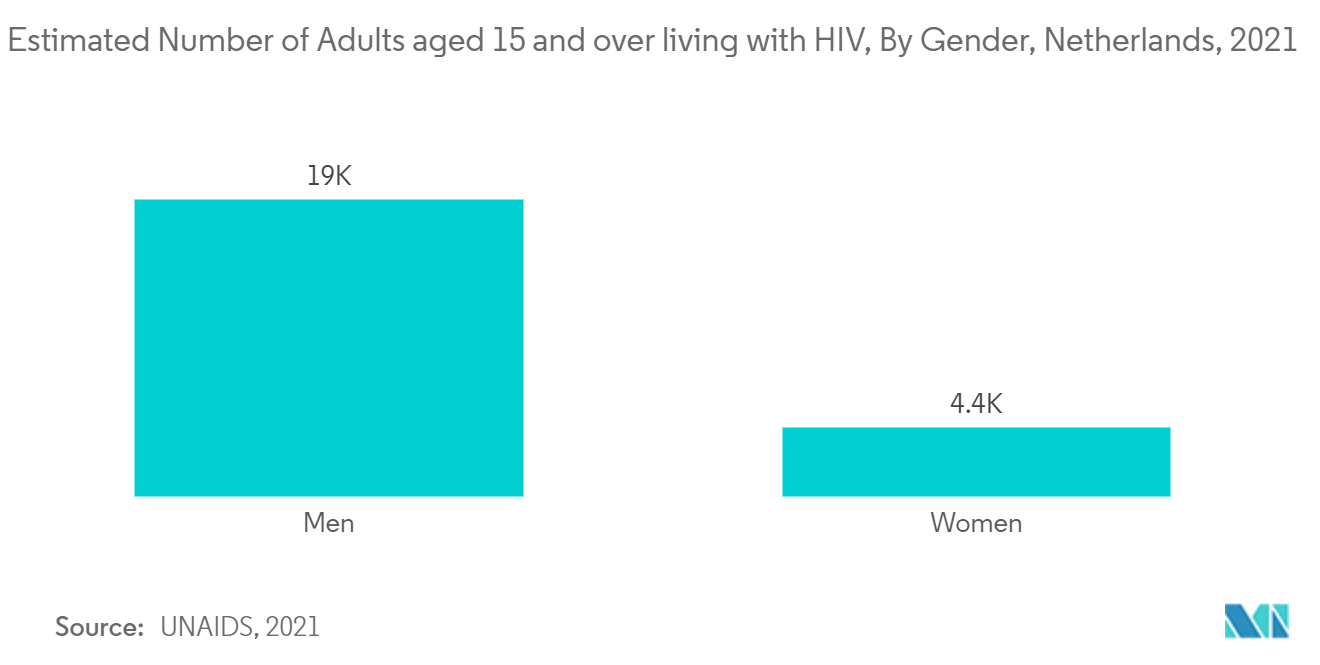
Netherlands Pharmaceutical Industry Overview
The Dutch pharmaceutical market is moderately fragmented and consists of several major players. In terms of market share, a few of the major players are currently dominating the market. Some prominent players are vigorously making acquisitions and joint ventures with other companies to consolidate their market positions in the country. Some of the key companies which are currently dominating the market are Abbott Laboratories, AbbVie Inc., Amgen Inc., Astellas Pharma, AstraZeneca PLC, F. Hoffmann-La Roche AG, Johnson & Johnson, Merck & Co., Novartis AG, and Pfizer Inc.
Netherlands Pharmaceutical Market Leaders
-
Abbott Laboratories
-
AbbVie Inc.
-
AstraZeneca Plc
-
Novartis AG
-
F. Hoffmann-La Roche AG
*Disclaimer: Major Players sorted in no particular order
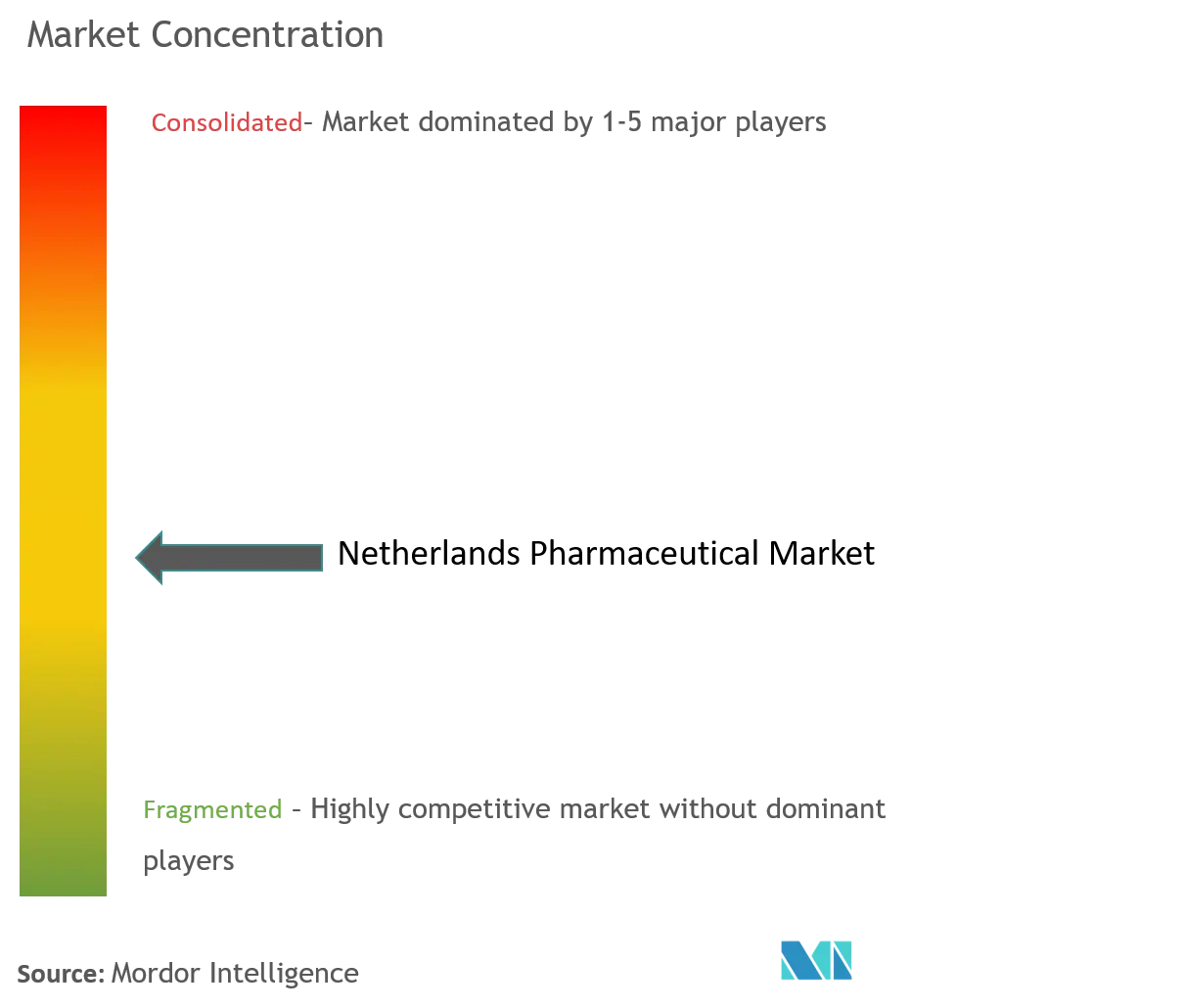
Netherlands Pharmaceutical Market News
- July 2022: The US FDA issued a warning letter to a dutch producer of active pharmaceutical ingredients (APIs). It was put on notice to adopt more robust equipment cleaning practices and use better safeguards to prevent cross-contamination.
- May 2022: Centrient Pharmaceuticals, a Netherlands-based pharmaceutical company, announced 100% compliance with the stringent Predicted No Effect Concentration (PNEC) discharge targets set by the anti-microbial resistance industry alliance for clean manufacturing of its full oral antibiotics product range.
Netherlands Pharmaceutical Market Report - Table of Contents
1. INTRODUCTION
1.1 Study Assumptions and Market Definition
1.2 Scope of the Study
2. RESEARCH METHODOLOGY
3. EXECUTIVE SUMMARY
4. MARKET DYNAMICS
4.1 Market Overview
4.2 Market Drivers
4.2.1 Presence of Better Research Institutes, Excellent Healthcare System, and an Innovation-friendly Government
4.2.2 Rising Cases of Chronic Diseases
4.3 Market Restraints
4.3.1 High Failure Rate and Developing Cost of New Products
4.4 Porter's Five Forces Analysis
4.4.1 Threat of New Entrants
4.4.2 Bargaining Power of Buyers/Consumers
4.4.3 Bargaining Power of Suppliers
4.4.4 Threat of Substitute Products
4.4.5 Intensity of Competitive Rivalry
5. MARKET SEGMENTATION (Market Size by Value - USD million)
5.1 By ATC/Therapeutic Class
5.1.1 Alimentary Tract and Metabolisma
5.1.2 Blood and Blood-forming Organs
5.1.3 Cardiovascular System
5.1.4 Dermatological Drugs
5.1.5 Genitourinary System and Reproductive Hormones
5.1.6 Systemic Hormonal Preparations, Excluding Reproductive Hormones and Insulins
5.1.7 Antiinfectives for Systemic Use
5.1.8 Antineoplastic and Immunomodulating Agents
5.1.9 Musculoskeletal System
5.1.10 Nervous System
5.1.11 Antiparasitic Products, Insecticides, and Repellents
5.1.12 Respiratory System
5.1.13 Sensory Organs
5.1.14 Various ATC Structures
5.2 By Mode of Dispensing
5.2.1 Prescription
5.2.2 OTC
6. COMPETITIVE LANDSCAPE AND COMPANY PROFILES
6.1 Abbott Laboratories
6.2 AbbVie Inc.
6.3 Amgen Inc.
6.4 Astellas Pharma
6.5 AstraZeneca PLC
6.6 F. Hoffmann-La Roche AG
6.7 Johnson & Johnson
6.8 Merck & Co.
6.9 Novartis AG
6.10 Pfizer Inc.
7. MARKET OPPORTUNITIES AND FUTURE TRENDS
Netherlands Pharmaceutical Industry Segmentation
Pharmaceuticals are referred to as prescribed and non-prescribed drugs. These medicines can be bought by an individual with or without the doctor's prescription and are safe for consumption for various illnesses with or without the doctor's consent. The report also covers an in-depth analysis of qualitative and quantitative data. The Dutch pharmaceutical market is segmented by ATC/therapeutic class (alimentary tract and metabolism, blood and blood-forming organs, cardiovascular system, dermatological drugs, genitourinary system and reproductive hormones, systemic hormonal preparations, excluding reproductive hormones and Insulins, antiinfectives for systemic use, antineoplastic and immunomodulating agents, musculoskeletal system, nervous system, antiparasitic products, insecticides and repellents, respiratory system, sensory organs, and various ATC structure), and mode of dispensing (Prescription and OTC). The report offers values in USD million for all the above-mentioned segments.
| By ATC/Therapeutic Class | |
| Alimentary Tract and Metabolisma | |
| Blood and Blood-forming Organs | |
| Cardiovascular System | |
| Dermatological Drugs | |
| Genitourinary System and Reproductive Hormones | |
| Systemic Hormonal Preparations, Excluding Reproductive Hormones and Insulins | |
| Antiinfectives for Systemic Use | |
| Antineoplastic and Immunomodulating Agents | |
| Musculoskeletal System | |
| Nervous System | |
| Antiparasitic Products, Insecticides, and Repellents | |
| Respiratory System | |
| Sensory Organs | |
| Various ATC Structures |
| By Mode of Dispensing | |
| Prescription | |
| OTC |
Netherlands Pharmaceutical Market Research FAQs
How big is the Netherlands Pharmaceutical Market?
The Netherlands Pharmaceutical Market size is expected to reach USD 9.92 billion in 2024 and grow at a CAGR of 7.5% to reach USD 14.24 billion by 2029.
What is the current Netherlands Pharmaceutical Market size?
In 2024, the Netherlands Pharmaceutical Market size is expected to reach USD 9.92 billion.
Who are the key players in Netherlands Pharmaceutical Market?
Abbott Laboratories, AbbVie Inc., AstraZeneca Plc, Novartis AG and F. Hoffmann-La Roche AG are the major companies operating in the Netherlands Pharmaceutical Market.
What years does this Netherlands Pharmaceutical Market cover, and what was the market size in 2023?
In 2023, the Netherlands Pharmaceutical Market size was estimated at USD 9.18 billion. The report covers the Netherlands Pharmaceutical Market historical market size for years: 2019, 2020, 2021, 2022 and 2023. The report also forecasts the Netherlands Pharmaceutical Market size for years: 2024, 2025, 2026, 2027, 2028 and 2029.
Netherlands Pharmaceutical Industry Report
The Netherlands pharmaceutical market is comprehensively covered in this report, which includes an industry analysis segmented by ATC/Therapeutic Class and Mode of Dispensing. The market overview highlights key segments such as Alimentary Tract and Metabolism, Blood and Blood-Forming Organs, Cardiovascular System, Dermatological Drugs, Genitourinary System and Reproductive Hormones, and more. The report provides a detailed market forecast, offering insights into market trends, market growth, and market value.
Industry trends and market segmentation are thoroughly examined to provide a clear market outlook. The report also includes a market review and industry statistics, presenting a comprehensive industry profile. It covers essential industry information and industry research, helping stakeholders understand the market structure and market predictions.
The report emphasizes the industry's growth rate and industry size, presenting data on industry sales and market data. The analysis pdf offers an in-depth look at the market leaders and their market share. The report pdf is available for those who want a detailed industry report and industry outlook.
Research companies and industry reports are crucial resources for understanding the sector analysis. This report also includes a market overview and market structure, providing a holistic view of the Netherlands pharmaceutical market. The industry analysis highlights the industry's worth and industry value, making it an essential resource for stakeholders looking for a comprehensive market analysis.



